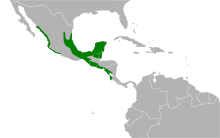|
Thicket tinamou
 The thicket tinamou or rufescent tinamou (Crypturellus cinnamomeus) is a type of tinamou commonly found in moist forests in subtropical and tropical central Mexico.[4] TaxonomyAll tinamou are from the family Tinamidae, and in the larger scheme are also ratites. Unlike other ratites, tinamous can fly, although in general, they are not strong fliers. All ratites evolved from prehistoric flying birds, and tinamous are the closest living relative of these birds.[5] René-Primevère Lesson identified the thicket tinamou from a specimen from La Unión, El Salvador., in 1842.[5] SubspeciesThe thicket tinamou has many subspecies as follows:
EtymologyCrypturellus is formed from three Latin or Greek words. kruptos (κρυπτός) meaning covered or hidden, oura meaning tail, and ellus meaning diminutive. Therefore, Crypturellus means small hidden tail.[6] DescriptionThe thicket tinamou is 27 to 29 cm (11–11 in) in length and weighs 440 g (16 oz).[5] Its upper parts are brown, heavily barred blackish on back, rump and wings. Its lowerparts pale brown, cinnamon on breast, greyer on belly and undertail whitish with dark barring. Its head brown with prominent buff supercilium and well-defined ear covert patch with bill brownish and legs red in color. BehaviorThe species has a monotonous voice ‘whoo-oo’, sounding like a steam engine. The thicket tinamou can be found in pairs, families or as a solitary bird and, like most tinamous, it prefers to walk than fly.[5] FeedingLike most tinamous, it will eat fruit, seeds and invertebrates.[5] Reproduction Like most tinamous, it will place its nest on the ground alongside raised roots. It will contain around three eggs, but as many as seven, that are glossy and purple in color. This species and the slaty-breasted tinamou will produce hybrids.[5] RangeThis species ranges from Sinaloa, (coastal strip, western Mexico), to Costa Rica, and eastern coastal Mexico, from the United States border into Belize. In the southern part of its range it ventures into the highlands as well.[4] HabitatThis species prefers moist lowland forest, gallery forest, deciduous forest, and secondary forest[3] in subtropical and tropical regions, but will be found in shrubland and drier forests up to 1,850 m (6,070 ft) altitude.[5][7] ConservationThe IUCN lists this bird as Least Concern,[1] with an occurrence range of 600,000 km2 (230,000 sq mi).[7] References
External linksWikimedia Commons has media related to Crypturellus cinnamomeus. |
||||||||||||||||||||||||||||||||||||||||||


